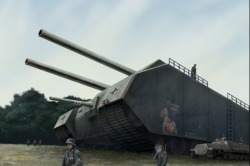Tanks
Little Willie

Little Willie was the first prototype tank ever made. The idea of an armoured tracked vehicle that would provide protection from machine gun fire was first discussed by army officers in 1914.Two colonels named Ernest Swinton and Maurice Hankey became convinced that it was possible to develop a fighting vehicle that could play an important role in the war. After observing early battles where machine gunners were able to kill thousands of infantryman advancing towards the enemy's, Swinton wrote that a "petrol tractors on the caterpillar principle and armoured with hardened steel plates" would be able to face the machine gunners. The tank had track frames 12 feet long, weighed 14 tons and could carry a crew of three, at speeds of just over three miles. The speed dropped to less than 2 mph over rough ground and was unable to cross trenches. Although the performance was disappointing, Ernest Swinton remained convinced that when fixed, the tank would enable the Allies to defeat the Central Powers.
Mark I

The British tank, Mark I, was a made by the British Army during WWI and the world's first combat tank, entering duty in August 1916, and first used in action on September 15, 1916.It was made to be able to cross trenches, resist machine guns, travel over difficult ground, carry supplies, and be able to capture enemy positions.The Mark I was an enhanced version of Little Willie(see above). Working on problems discovered with Willie, the Mark I was designed by Wilson. The prototype Mark I, ready in December 1915, was called "Mother", (previous names were "The Wilson Machine", "Big Willie", and "HMLS Centipede"). One hundred and fifty of the Mark I were built.
German Super Tank

The Landkreuzer P1000 Ratte was a huge German Super Tank designed in 1942 but was canceled in early 1943. It was known that German's didn't even refer to it as a tank, but as a "land cruiser." It was so large that it's dimensions had more in common with a naval vessel than a tank. In June 1942, Hitler and Krupp discussed the idea of building a one thousand ton super heavy tank. It's weapons would have been the size's of a battleship's. If made, it would have been the largest tank ever built and would've easily destroyed enemy ground forces through out Europe. The cost of building this kind of machine would have been enormous and transportation of this beast would've been nearly impossible. Development of the tank was completely canceled in 1943 by the wise German Minister of Armaments, Albert Speer.
